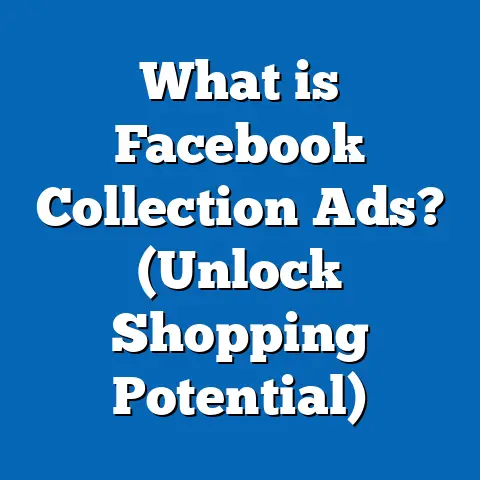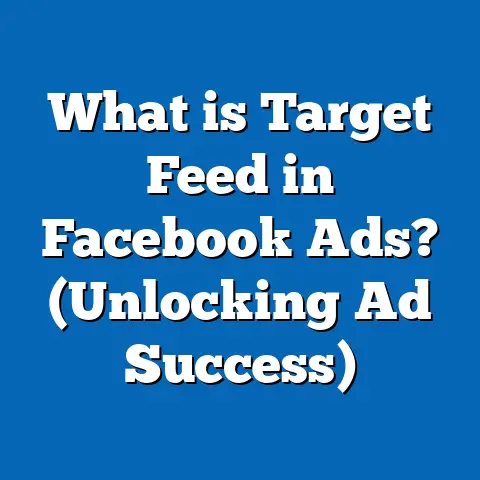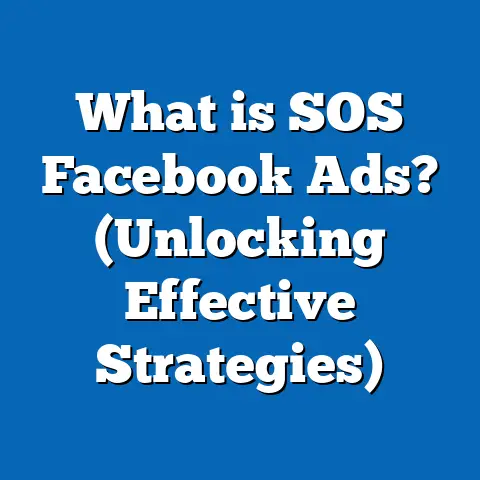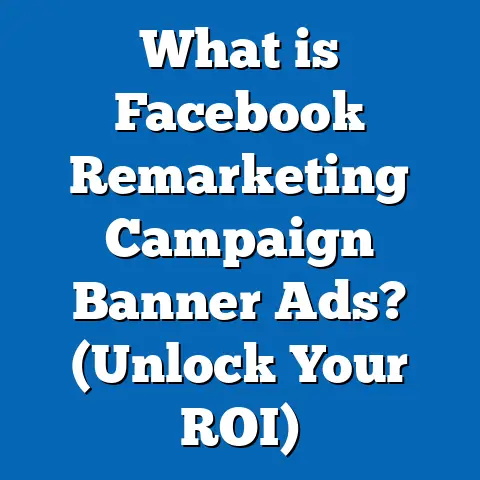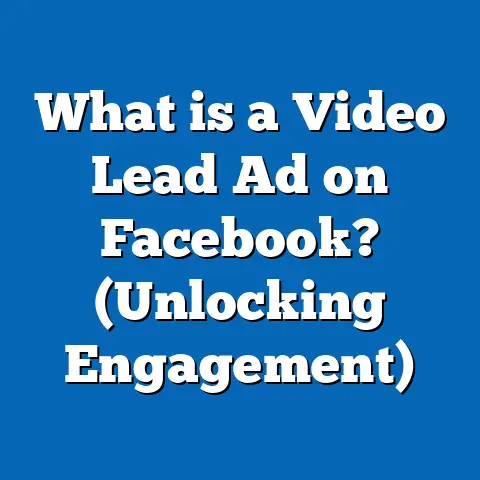What is the Creative in Facebook Ads? (Unlocking Engagement Secrets)
What is the Creative in Facebook Ads? (Unlocking Engagement Secrets)
Introduction: Why the Creative Matters More Than Ever
In today’s online world, your brand’s survival often hinges on a split-second decision made by a user scrolling through their Facebook feed. Among the sea of posts, videos, memes, and ads, what makes someone stop, look, and engage with an advertisement? The answer lies in the “creative” — the core visual and textual elements that shape every Facebook ad.
But why is understanding the creative so crucial? Because even with perfect targeting, budgets, and bidding strategies, a poorly designed creative can tank an entire campaign. On the flip side, a well-crafted creative can elevate your ad’s impact exponentially.
Understanding Facebook Ad Creative: The Foundation of Your Campaigns
What Exactly Is the Creative in Facebook Ads?
Facebook ad creative refers to all visual and textual elements users see when an ad appears on their feed or stories. Specifically, these include:
- Images: Single or multiple photos used in static or carousel ads.
- Videos: Short clips or longer videos showcasing products, storytelling, or brand messaging.
- Headlines: The bold text that summarizes the message or offer.
- Primary Text: The main body copy that appears above or below the visual.
- Descriptions: Additional text below headlines (optional).
- Call-to-Action (CTA) Buttons: Directives like “Shop Now,” “Sign Up,” or “Learn More.”
- Ad Formats: Carousel, slideshow, collection, instant experience (full-screen mobile ads), etc.
Each element plays a role in capturing attention and guiding user behavior.
Why Does Creative Matter So Much?
According to Facebook’s Q4 2023 advertising report, over 4 million advertisers compete daily for user attention. This saturation means users scroll fast, making it harder than ever to capture their interest.
- WordStream’s 2023 data shows ads with compelling creatives achieve CTRs up to 7x higher than those with generic creatives.
- A report by AdEspresso reveals that ads with video creatives have a 135% higher engagement rate than image-only ads.
- According to Facebook’s own internal research, creative quality can reduce cost per click (CPC) by up to 45%.
In short, the creative is not just a component of your ad—it is the driver of engagement and conversions.
The Anatomy of a High-Performing Facebook Ad Creative
Visual Elements: The Power of Images and Videos
Visuals are the first thing users notice as they scroll. Research by HubSpot shows that 65% of people are visual learners, making images and videos crucial in digital marketing.
Images: Best Practices for Static Visuals
- High Resolution: Low-quality images degrade trust.
- Bright Colors & Contrast: They make ads stand out in crowded feeds.
- Human Faces: Ads featuring faces increase conversions by up to 35% because they build emotional connections.
- Product Focus: Show your product clearly in use or context.
- Branding: Subtle logos or colors help create brand recall without overwhelming.
Videos: Why They Outperform Images
Video ads on Facebook have an average engagement rate of 6.13%, compared to 3% for image ads (Social Media Examiner, 2024). Videos allow storytelling, demonstrations, and evoke emotions better than images.
Video Tips:
- Keep videos between 10–15 seconds for mobile-first consumption.
- Use captions since many watch without sound.
- Start with a hook in the first 3 seconds.
- Show benefits quickly; avoid long intros.
Copywriting: Crafting Messages That Convert
The words you use can make or break your ad. According to Copyblogger, 80% of people read headlines, but only 20% read the rest of the copy.
Key Copywriting Principles:
- Clear & Concise Headlines: Grab attention and communicate value.
- Benefit-Oriented Language: Explain how your product solves problems.
- Emotional Triggers: Use phrases that evoke curiosity, urgency, or happiness.
- Simple Language: Avoid jargon; keep it conversational.
- Strong CTA: Tell users exactly what to do next.
Example headline vs. benefit-driven headline:
- “New Running Shoes Available”
vs. - “Run Faster & Feel Better with Our New Running Shoes”
The second example connects with user desires.
Call to Action (CTA): Driving the Next Step
Choosing the right CTA button increases conversions significantly. In a study by WordStream:
- Ads with tailored CTAs had a 30% higher conversion rate than generic CTAs.
Common CTAs include:
- Shop Now
- Sign Up
- Learn More
- Download
- Get Offer
Always align your CTA with your campaign objective.
Data-Backed Insights: What Research Says About Facebook Creatives
Case Study 1: E-commerce Brand Boosts Sales by 50% Using Video Creatives
Background: A fashion retailer struggled with low engagement on static ads.
Strategy: They switched to short lifestyle videos showing their apparel in real-life scenarios.
Results:
| Metric | Before (Static Ads) | After (Video Ads) | % Change |
|---|---|---|---|
| Click-through Rate | 1.2% | 3.5% | +192% |
| Cost per Click | $0.85 | $0.68 | -20% |
| Sales Increase | Baseline | +50% | +50% |
The authentic feel of video boosted customer trust and interest.
Case Study 2: Tech Startup Doubles Lead Generation with Personalized Creatives
Background: A SaaS company wanted more qualified leads for its software platform.
Strategy: Used Facebook’s Dynamic Creative Optimization (DCO) to deliver personalized headlines and images based on viewer data.
Results:
| Metric | Generic Creative | Personalized Creative | % Change |
|---|---|---|---|
| Lead Generation | 500 leads/month | 1,000 leads/month | +100% |
| Cost per Lead | $25 | $15 | -40% |
| Conversion Rate | 6% | 9% | +50% |
Personalization made creatives more relevant and compelling.
Advanced Creative Strategies: Beyond Basics
Dynamic Creative Optimization (DCO)
DCO allows advertisers to upload multiple versions of headlines, images, texts, and CTAs. Facebook then dynamically tests combinations against audiences and optimizes delivery for best performance.
Benefits of DCO:
- Saves time on manual A/B testing.
- Finds winning combinations faster.
- Adapts creatives based on audience preferences.
Businesses using DCO often see 15–25% uplift in CTR compared to static creatives.
Interactive Ads: Engaging Audiences in New Ways
Facebook supports interactive ad types such as polls within ads or playable game demos.
Advantages:
- Higher engagement rates (up to 50% more).
- Longer time spent on ads boosts brand recall.
Example: A gaming company used playable ads allowing users to try mini-games directly in Facebook. This resulted in a 60% increase in app installs compared to video ads alone.
Leveraging User-Generated Content (UGC)
UGC involves using real customer photos, reviews, or testimonials inside your ad creative.
Why UGC Works:
- Builds authenticity and trust.
- Social proof increases buyer confidence.
Studies show UGC-based ads have a 20–25% higher conversion rate than traditional brand-created ads.
Comparing Facebook Creatives with Other Platforms
| Feature | Google Ads | ||
|---|---|---|---|
| Creative Types | Image, Video, Carousel, Stories | Image, Video, Stories | Text ads; Responsive Display Ads |
| Engagement Focus | Social interactions & sharing | Visual storytelling | Intent-driven search |
| Best Performing Formats | Video & Carousel | Stories & Reels | Responsive display ads |
| Personalization Tools | Dynamic Creative Optimization | Limited dynamic options | Responsive ads & audience targeting |
| Audience Targeting | Detailed demographic & interest-based | Highly visual & influencer-driven | Keyword & intent-based targeting |
Facebook excels in combining social proof with diverse creative formats optimized for engagement and conversions.
Technical Aspects Simplified: How Facebook Uses Creative Data
Facebook’s algorithm evaluates each creative based on user interactions such as clicks, comments, shares, view time (for videos), and conversion events. It uses this data to predict which ads users are likely to engage with and prioritizes showing those more often.
Practical Implications for Advertisers
- Monitor ad relevance score and engagement metrics closely.
- Refresh creatives regularly to avoid audience fatigue.
- Use split testing tools within Ads Manager for controlled experiments.
- Analyze which creative elements drive the most impact (images vs. copy vs. CTA).
Step-by-Step Guide: Creating Winning Facebook Ad Creatives
Step 1: Define Your Objective Clearly
Are you aiming for brand awareness? Lead generation? Direct sales? Your creative should reflect this goal.
Step 2: Understand Your Audience Deeply
Use Facebook Audience Insights to learn demographics, interests, and behaviors. Tailor visuals and messaging accordingly.
Step 3: Choose the Right Format
Decide between single images, carousels (multiple images), videos, or collections based on your product and message complexity.
Step 4: Craft Your Visuals
Invest in professional photography or video production. Use bright colors and human elements where possible.
Step 5: Write Powerful Copy
Focus on benefits and solutions. Keep it concise but compelling. Include social proof if available (testimonials).
Step 6: Select Effective CTAs
Match your CTA button to your campaign goal (e.g., “Shop Now” for e-commerce).
Step 7: Test Multiple Variations
Use A/B testing or Dynamic Creative Optimization to find winning combinations.
Step 8: Launch and Monitor Closely
Track CTRs, CPCs, conversion rates daily for initial weeks. Pause underperformers quickly.
Step 9: Optimize Continuously
Iterate based on data insights. Refresh creatives every few weeks to combat ad fatigue.
Results:
| Metric | Before Carousel Ads | After Carousel Ads | % Change |
|---|---|---|---|
| Reservation Clicks | 150/month | 255/month | +70% |
| Cost per Reservation Click | $3.00 | $1.75 | -41.6% |
Users enjoyed browsing options visually before deciding.
Case Study 4: Fitness Brand Uses UGC Videos to Lift Conversions by 35%
Fitness apparel brand collected short videos from customers using products during workouts. These were repurposed into ads featuring real testimonials combined with product shots.
Results:
| Metric | Generic Promo Video | UGC Video Ads | % Change |
|---|---|---|---|
| Conversion Rate | 4.8% | 6.5% | +35% |
| Cost per Acquisition | $40 | $26 | -35% |
Authentic stories resonated more than polished but generic promos.
Common Mistakes to Avoid in Facebook Ad Creatives
- Ignoring Mobile Optimization: Over 98% of Facebook users are on mobile; creatives must load fast and display clearly on small screens.
- Using Too Much Text in Images: Facebook limits text overlay; too much text reduces reach drastically.
- Neglecting Testing: Relying on one creative without testing multiple versions limits potential performance gains.
- Weak CTA: Ambiguous calls-to-action confuse users rather than guide them.
- Lack of Alignment With Audience Needs: Irrelevant creatives fail regardless of quality.
Latest Industry Trends Impacting Facebook Ad Creatives (2024 Update)
- Short-form Video Dominance: Reels and Stories formats continue growing rapidly with higher engagement rates than traditional posts.
- Augmented Reality (AR) Ads: Brands use AR filters for interactive experiences driving deeper engagement.
- Increased Use of AI Tools for Creative Generation: AI now helps generate video scripts, design mockups, and optimize creatives faster.
- Privacy Changes Impacting Retargeting: With iOS privacy updates limiting tracking, creative relevance becomes even more critical to capture initial interest without heavy retargeting.
- Sustainability Messaging Gaining Traction: Consumers respond better when brands show environmental responsibility through authentic visuals and messages.
How to Measure Creative Success Effectively
Focus on these key metrics:
- CTR (Click-through rate): Measures how well creative drives clicks.
- Engagement Rate: Likes, comments, shares indicating emotional connection.
- Conversion Rate: Percentage of users completing desired actions post-click.
- Cost Per Result: How much you pay per lead, sale, or registration.
- Frequency: How often users see your ad; too high causes fatigue.
- Relevance Score/Quality Ranking: Facebook’s internal measure of ad quality based on feedback.
Use these metrics collectively rather than individually for a full picture of creative effectiveness.
Summary: Unlocking Engagement Secrets Through Creative Mastery
The creative is more than just images and words—it’s your brand’s voice in a noisy marketplace. Strong creatives grab attention instantly, communicate value clearly, and persuade effectively through emotion and logic combined.
Mastering Facebook ad creatives requires:
- Deep understanding of audience psychology
- Skillful design and copywriting
- Data-driven testing and optimization
- Staying updated with platform trends and tools
By committing resources and strategy toward creative excellence, marketers can significantly boost engagement rates, reduce costs, and maximize ROI on Facebook advertising campaigns.
Next Steps for Marketing Professionals and Business Owners
- Conduct a full audit of your current Facebook ad creatives.
- Develop a creative testing plan using DCO or manual A/B tests.
- Invest in high-quality visuals—consider professional photography/video production if budget allows.
- Craft compelling copy focused on benefits and emotions.
- Experiment with interactive formats like polls or AR filters where relevant.
- Monitor performance metrics closely; refresh creatives regularly.
- Stay informed about evolving trends like short-form video dominance and AI tools.
With these actions, you unlock the true potential hidden inside your Facebook advertising campaigns—turning passive scrolling into active engagement and business growth.
If you want me to provide detailed templates for ad creatives or technical setup walkthroughs next, just let me know!

